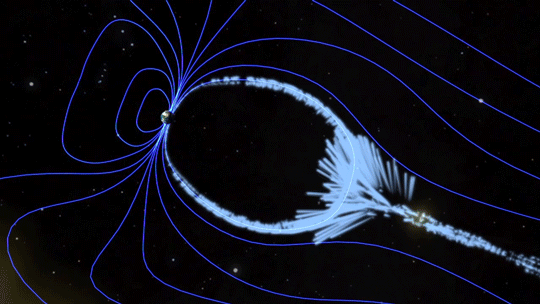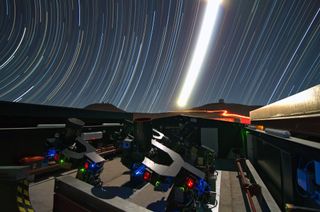Over the weekend, astronomers and space enthusiasts everywhere caught a glimpse of SpaceX’s recently launched Starlink satellites in the sky. They’re the first 60 spacecraft of nearly 12,000 the company plans to launch for its massive “internet from space” initiative. For many on the internet, it was an amazing sight to see. For the astronomy community, it was devastating to watch.
The satellites, strung out like a line of glowing army ants, shone brightly as they moved along their orbit around Earth, clearly visible to the naked eye. Now, many in the astronomy community are concerned that this mega constellation might be too bright, and the sheer number of satellites that SpaceX wants to launch could muck up their telescope observations of the Universe.
“It’s going to become increasingly likely that the satellites will pass through the field of view and essentially contaminate your view of the Universe,” Darren Baskill, an outreach officer of physics and astronomy at the University of Sussex, tells The Verge. “And it’s going to be really difficult to remove that contamination away from our observations.”
Satellites are already an issue for astronomers studying celestial objects in deep space. In order to get detailed images of objects many light-years away from Earth, astronomers take long-exposure shots of the sky with their telescopes. This type of imaging entails leaving the telescope exposed to light for minutes or hours. As a result, scientists can gather light from a very distant, faint object and figure out more about it. For instance, it’s a great way to learn what kinds of gases are in a faraway galaxy. Each type of gas emits different types of light, which astronomers can detect and identify.
But whenever a super bright object passes through the field of view of a long-exposure shot, the observation gets muddied. The light from that object tears through the image, causing a long, bright streak through the sky. Satellites can be particularly bright since they’re often made with reflective materials or have solar panels that bounce light from the Sun. “If it was just a point in an image, that wouldn’t be too bad,” Phil Bull, a theoretical cosmologist at Queen Mary University of London, tells The Verge. “You could just ignore the bit around that point. But because it’s a big line going through your image, it really gets in the way.”
Currently, there are about 5,000 satellites in orbit around Earth, around 2,000 of which are still operational, according to the most recent report from the European Space Agency. These objects already cause the occasional streak and headache for astronomers. But with the addition of SpaceX’s Starlink constellation, as well as other proposed mega constellations from OneWeb, Telesat, Kepler Communications, and now Amazon, the number of operational satellites could increase significantly. And that could drastically up the risk of satellites streaking across a telescope’s sightline.
But exactly how often this interference will happen remains to be seen. It all depends on where the satellites are above the Earth, the time of day, and the time of year. Satellites can be seen for a few hours around dusk and dawn when they catch the light from the Sun as the sky dims, but they won’t reflect light for many hours of the night whenever they are in the shadow of the Earth. However, in higher latitudes during the summer, satellites can be seen throughout the evening. That’s because they’re high enough in the sky to still catch the Sun and stay out of the Earth’s shadow. “You can go into your backyard with some binoculars or even the naked eye, and you can see plenty of satellites whizzing around a few hours past dusk or before dawn,” says Bull. “It’s really not like they just instantly switch off when the sun sets on Earth.”
The problem is there is very little public data on how such giant constellations could pollute the night sky with light. There’s been a lot of discussion about how these mega constellations will potentially run into each other, causing debris that could pose a danger to other satellites in the sky. But the discussion of light pollution exploded over the weekend after amateur astronomers released footage of the Starlink satellites, showing them to be much brighter than people imagined. “There are plenty of us in the community that were aware of this concern, but until people saw with their own eyes this freight train of satellites, it didn’t really jump into the public consciousness,” Mary Knapp, a research scientist studying exoplanets at MIT Haystack Observatory, tells The Verge.
The Verge reached out to the Federal Communications Commission, which provided the license for Starlink, but we did not receive a response in time for publication. We also reached out to SpaceX twice but did not receive a response.
One astronomer, Cees Bassa, attempted to do the math and calculated just how many of these satellites might be visible in the sky at one time. For his analysis, he factored in the first leg of SpaceX’s Starlink constellation — about 1,600 satellites — as there are better details about the orbits they’re going to. Based on just that initial batch, he estimated that at a latitude of 52 degrees north (about where London is located), there will be 84 Starlink satellites above the horizon at all times. And for many hours around dusk, dawn, and in the nighttime during summer, 15 of those satellites would be visible in the sky at all times, about 30 degrees above the horizon.
Of course, that’s just the first batch of Starlink satellites; the impact of additional spacecraft could be worse. Bassa argues he didn’t go beyond the initial 1,600 in his calculations because he didn’t have accurate orbital data for the rest of the satellites — and their height affects their brightness. “If they’re higher, they’ll be fainter but visible for longer,” Bassa, an astronomer at the Netherlands Institute for Radio Astronomy, tells The Verge. “If the satellites are in lower orbits, they will be brighter but visible for less long.” Additionally, sometimes satellites can momentarily get brighter when they happen to catch the light from the Sun, causing more interference.
Over the weekend, SpaceX CEO Elon Musk tried to downplay the astronomy community’s concerns, arguing that Starlink would have “~0% impact on advancements in astronomy.” He also claimed that the satellites would not be visible when the stars are out and that the reason the International Space Station is visible at night is because it’s big and has lights — two statements that aren’t true. (The ISS has very large solar panels that reflect lots of sunlight, even at nighttime on Earth.) Musk ultimately argued that “we need to move telescopes to orbit anyway” since these instruments have to deal with interference from Earth’s atmosphere.
That statement is naive, according to many astronomers. Telescopes can be built much bigger on Earth with dishes more than 30 meters (98 feet) in diameter, allowing astronomers to take in a lot of light and get more detailed observations. Launching such a massive telescope off of Earth is incredibly difficult, requiring giant rockets or very complex engineering. Right now, NASA is working toward launching its biggest space telescope yet, the James Webb Space Telescope, which has a primary mirror that’s a little more than 20 feet wide. Developing that telescope for launch and for space has taken decades, and the cost has ballooned to nearly $10 billion. “Taking these apertures off of the Earth and putting them in space is not technically feasible right now,” says Knapp. “And when and if it becomes so, it’s very, very expensive, much — much more expressive than the telescopes we have on the ground of similar size.”
In the end, even space-based telescopes in orbit around Earth still have problems with satellites. “We see satellites in space-based observations, too, when the satellites are above the space telescope,” says Knapp. “So it’s not just a ground-based observational problem.”
The good news is that the current batch of Starlink satellites are already getting dimmer, as they are slowly moving to their final higher orbits and spreading far apart. Many astronomers are eagerly waiting to see just how dim they become to better understand what the final effect of the Starlink constellation will be. After lots of backlash, Musk did say that SpaceX could tweak the orientation of these satellites to minimize any disturbance of astronomical observations, claiming that “we care a great deal about science.”
But it’s not just light that astronomers are worried about. Some are concerned that the radio frequencies these satellites will be transmitting on will also interfere with radio observations of the Universe. Often, astronomers will study radio waves coming from distant objects to learn more about them, especially hot bodies like stars that emit super intense X-rays that can be measured from Earth. Musk did say that SpaceX’s Starlink satellites won’t transmit at certain frequencies to avoid astronomy observations, but it could still create a blind spot. “As technology has progressed, the ability to look at the Universe at all frequencies has expanded greatly,” Colin Lonsdale, the director of the MIT Haystack Observatory, tells The Verge. “So what something like Starlink will do, it’ll shut off some of those frequencies from the possibility of study.” Lonsdale also argues that there is a possibility that there will be some level of transmission that spills outside the intended frequency bands.
Overall, Musk argues that providing global internet coverage is the “greater good” in the long run. Ultimately, many astronomers don’t want to stand in the way of this type of innovation, but many have also expressed interest in more data and discussions about the impact of the Starlink constellation on the night sky as well as other proposed internet satellite initiatives. “There’s been a long and very productive partnership between astronomers and the technology side of things to try and find solutions that work for everyone,” says Bull. “As far as I’m aware, that just hasn’t happened here. And to be honest, it’s unusual to have not consulted on this kind of impact.”
Let's block ads! (Why?)
https://www.theverge.com/2019/5/29/18642577/spacex-starlink-satellite-constellation-astronomy-light-pollution
2019-05-29 15:12:42Z
52780303931193


















